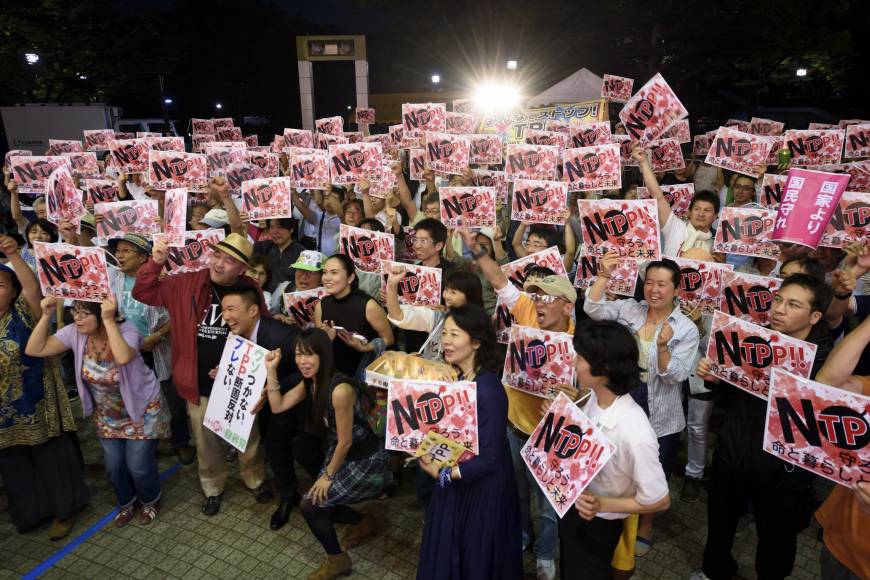TPP-11 opens doors to new members
Nikkei Asian Review | 19 January 2019
TPP-11 opens doors to new members
by WATARU SUZUKI
TOKYO — The Comprehensive and Progressive Trans-Pacific Partnership (TPP-11), a trade pact among 11 Pacific Rim nations, officially opened its doors to new members on Saturday in a move aimed at bolstering free trade at a time when the U.S. and China remain locked in a trade war.
After holding its first ministerial-level talks in Tokyo since the so-called TPP-11 came into effect on Dec. 30, signatories agreed on the process for approving new members.
"There is a temptation toward protectionism, but we must not rewind the clock," Japanese Prime Minister Shinzo Abe said in his opening remarks. "For all countries that resonate with our philosophy and are ready to accept the TPP-11’s high standards, the door is open. I expect participation from many countries seeking free and fair trade."
In a joint statement, the TPP-11 signatories also said the agreement "sends a strong signal in support of free trade."
The TPP-11 creates a trade bloc covering 500 million people and $10 trillion in gross domestic product — around 13% of the world’s total. Signatories, which include Japan, Australia, Canada and Vietnam, have pledged to slash tariffs on wine, fish and other agricultural products, and rules on data storage requirements were drawn up to cope with rapidly expanding digital industries.
The pact came into effect nearly two years after U.S. President Donald Trump pulled the U.S. out of the deal.
Countries and regions ranging from Thailand, Taiwan to Colombia and the U.K. have expressed interest in joining the TPP-11. Toshimitsu Motegi, Japan’s minister in charge of the negotiations, did not comment on specific countries but said in a news conference that "extending the TPP-11’s new rules to as many countries and regions as possible is our common goal."
Negotiations with Thailand are expected to start as early as this spring. Motegi also suggested that Japan would urge the U.S. to consider returning to the TPP. Japan has been particularly keen to position itself as a linchpin of free trade as it gears up to host the G-20 summit in Osaka this year.
But while expanding the pact may further boost trade activity, accepting new members is a grueling process. A country wishing to join needs the approval of all existing members, who discuss the issue in a working committee. In addition, four of the 11 current signatories — Brunei, Chile, Peru and Malaysia — have not yet ratified the pact, a process that Motegi said is the "top priority."
In particular, Malaysia, under the new administration of Prime Minister Mahathir Mohamad, has not yet decided whether to ratify the TPP-11. "It is taking time to evaluate because this deal was done during the previous government. It is fair that the current government be given the opportunity to assess the agreement, whether it really provides the benefit of free and fair trade to the people of Malaysia," said Isham Ishak, the Malaysian representative who participated in Saturday’s meeting.
Whether the TPP-11 can continue its liberalization agenda will be a gauge of how free trade will evolve at a time when trade relations between the U.S. and China, the two largest economies in the world, continue to be surrounded by uncertainty. The two sides are reportedly moving toward a deal that will de-escalate the addition of tariffs on each other’s imports, but in the meantime, regional trade deals involving the two countries have stalled.
China, which is not a member of the TPP-11, is pursuing another giant multilateral trade deal called the Regional Comprehensive Economic Partnership. But efforts to conclude talks have been delayed as negotiations over the degree of liberalization by key members like India face difficulties. Negotiations are expected to accelerate after India holds general elections by May.
An ambitious plan to establish an even larger trading bloc among the 21 members of the Asia-Pacific Economic Cooperation, which includes the U.S. and China, stalled last year as Washington and Beijing exchanged barbs over trade.






